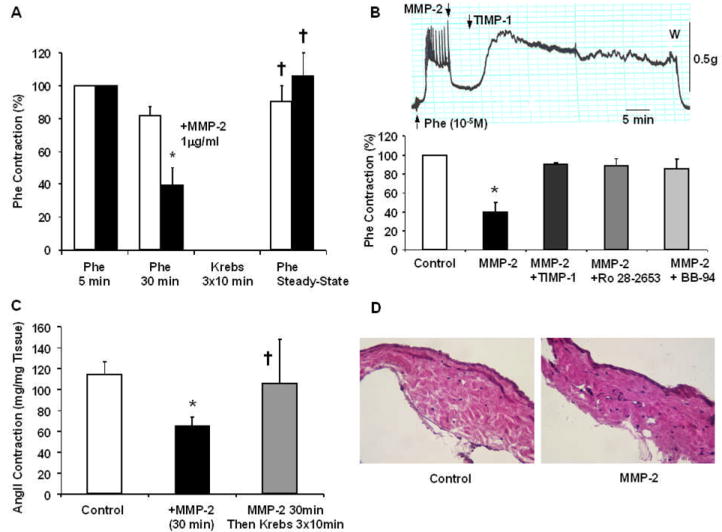Fig. 1.

Reversibility and specificity of the effects of MMP-2. Rat IVC segments were treated with Phe (10-5 M), the steady-state contraction at 5 min and sustained contraction at 30 min were measured, the tissues were washed with Krebs, then a second control Phe contraction was elicited (A, Unfilled Bars). Other tissues were precontracted with Phe (10-5 M), treated with MMP-2 (1 μg/ml) for 30 min, washed in Krebs, then a second Phe contraction was elicited to demonstrate reversibility of the effects of MMP-2 (A, Solid Bars). To test the specificity of the effects of MMP-2, the experiments were repeated in IVC segments treated with MMP inhibitors TIMP-1 (1 μg/ml), Ro 28-2653 (10-6 M), and BB-94 (10-6 M) (B). In a representative tracing, when MMP-2 induced IVC relaxation reached steady-state TIMP-1 was added and reversal of the effects of MMP-2 was observed (B, upper panel). Aggregate data of Phe contraction in the absence and presence of MMP-2, and specific inhibitors of MMPs were also measured (B, lower panel). Other IVC segments were nontreated, pretreated with MMP-2 for 10 min, or pretreated with MMP-2 for 10 min followed by 3 washings in Krebs then stimulated with AngII (10-6M) and the peak contractile response was measured (C). Sections of IVC nontreated (control) and treated with MMP-2 were stained with hematoxylin and eosin to demonstrate the integrity of the vein wall and minimal evidence of structural degradation (D, Total Magnification 200). Data represent means±SEM of 4-24 measurements.
* Significantly different from control p<0.05
† Not significantly different from control
